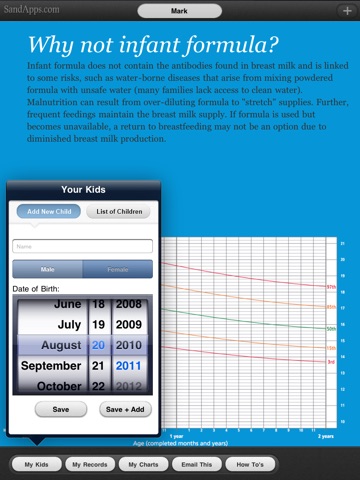
Growth Charts for Breast Fed Babies, Infants app for iPhone and iPad
Developer: Sand Apps Inc.
First release : 02 Mar 2011
App size: 51.94 Mb
Breast Fed Babies grow differently than babies on formula. Track them in a system that is designed for their growth patterns. Understand why it is better to breast feed with quotes from leading medical sources. From the first drink of Colostrum your baby has, track their expected progress for the next five years.
Made by parents for parents.
What do these charts look like, and what do they show?
===========================================
Parents, caregivers and health workers around the world are familiar with growth references. They are the values of weight and height for each age against which they measure the growth of the children under their care. The current references do not indicate how children should grow for the best health outcome, however, rather they simply describe how the average child grows.
These Child Growth Standards go beyond the current references. They allow important growth measurements, such as body weight and length/height of infants and children to be assessed against a standard optimum value. There are charts for boys and for girls, and for infants to one year, and for children up to five years.
These measurements are important indicators of health and help determine whether a child or a population of children is healthy and growing well. For example, children who are short for their age (below the red line on the length/height chart) or underweight (below the red line on the weight chart) indicate that their health may be compromised - the further from the red lines, the more
indicative of a health problem. In clinical practice, these measurements help with early diagnosis of illness and help monitor progress during treatment.
Importantly, for the first time there now exist standardized Body Mass Index - BMI - charts for infants to age five, which is particularly useful for monitoring the increasing epidemic of childhood obesity.

